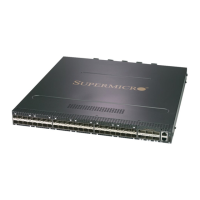Supermicro SSE-F3548S/SSE-F3548SR Configuration User’s Guide
Port TxFlowControl Rx FlowControl Tx Pause Rx Pause
---- -------------- ------------- -------- --------
Fx0/22 on off 0 0
2.3.7 Storm Control
Storm control prevents traffic on a LAN from being disrupted by a broadcast, multicast, or unicast storm on
one of the physical interfaces. A LAN storm occurs when packets flood the LAN due to errors or mistakes in
network configurations, etc. LAN storms degrade network performance.
Storm Control monitors packets passing from an interface to the switching bus and determines if the
packet is unicast, multicast, or broadcast. The switch counts the number of packets of a specified type
received within the 1-second time interval and compares the measurement with a predefined suppression-
level threshold. The port blocks traffic when the rising threshold is reached and remains blocked until the
traffic rate drops below the falling threshold before resuming normal forwarding.
Follow the steps below to configure Storm control.
Enters the configuration mode
interface <interface-type><interface-id>
or
interface range <interface-type><interface-id> ….
Enters the interface configuration
mode.
interface-type – may be any of the
following:
fx-ethernet – fx
cx-ethernet – cx
interface-id is in slot/port format for all
physical interfaces.
To configure multiple interfaces, use
the “interface range …” command. To
provide a range use a hyphen (-)
between the start and end interface
numbers. E.g.: int range fx 0/1-10
To provide multiple interfaces or
ranges, separate with a comma (,).
E.g.: int range fx 0/1-10, fx 0/20
If multiple interfaces are provided, the
next step will perform the particular
configuration on all these interfaces.
storm-control { broadcast |multicast | dlf } level
<kbps (1-10000000)>
Configure Storm control for broadcast
or multicast or DLF packets.
Level – Threshold level in kbps, in range

